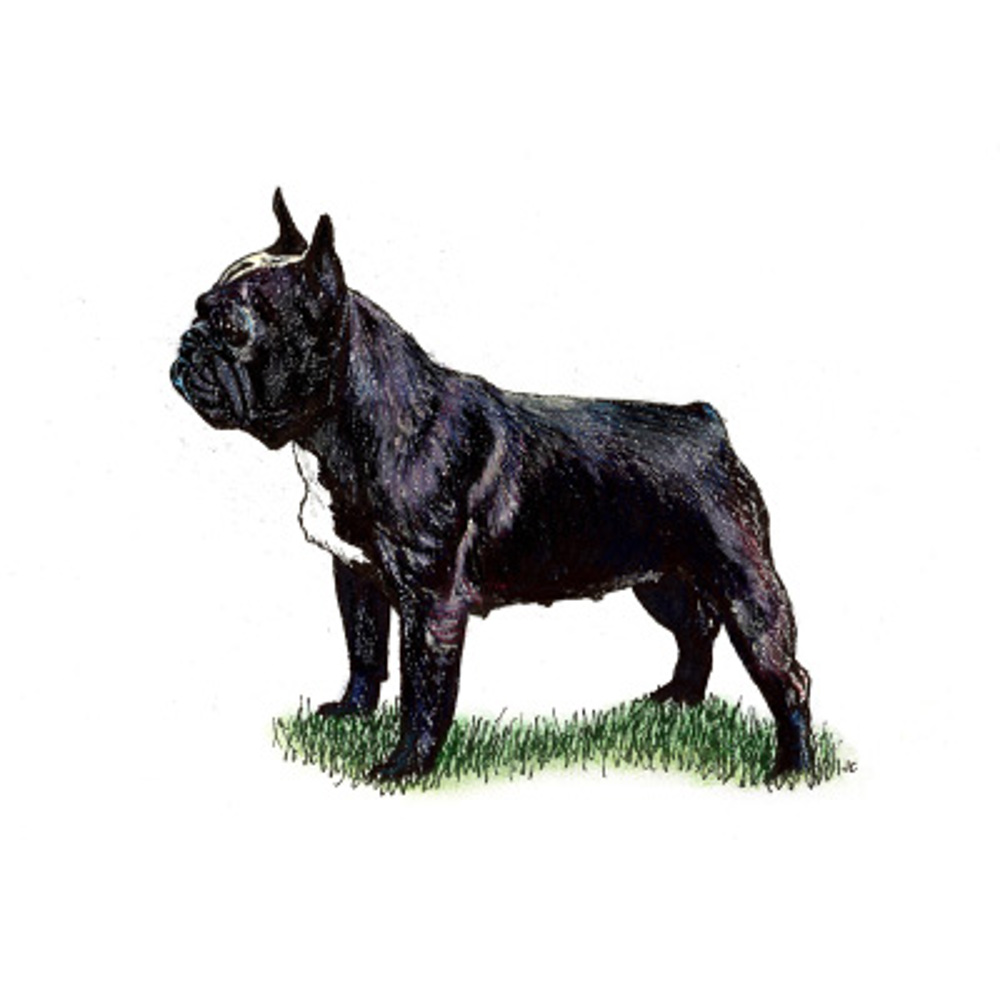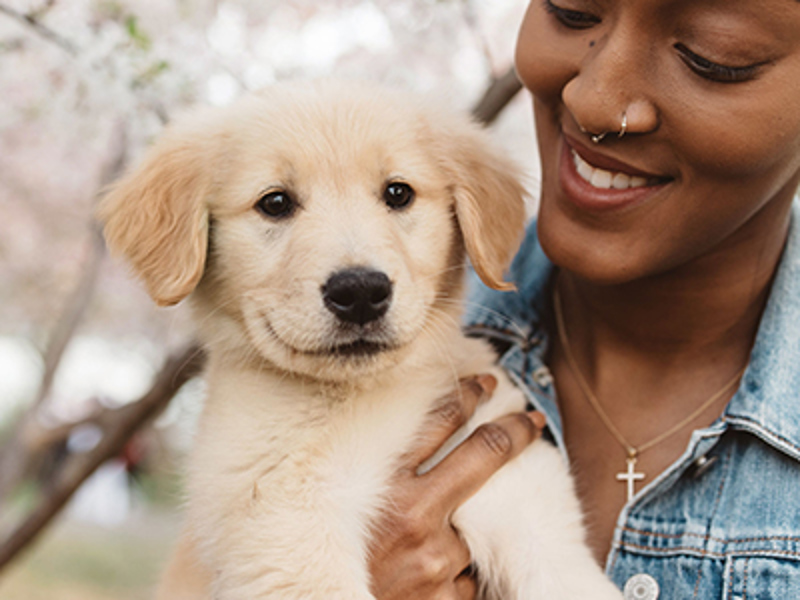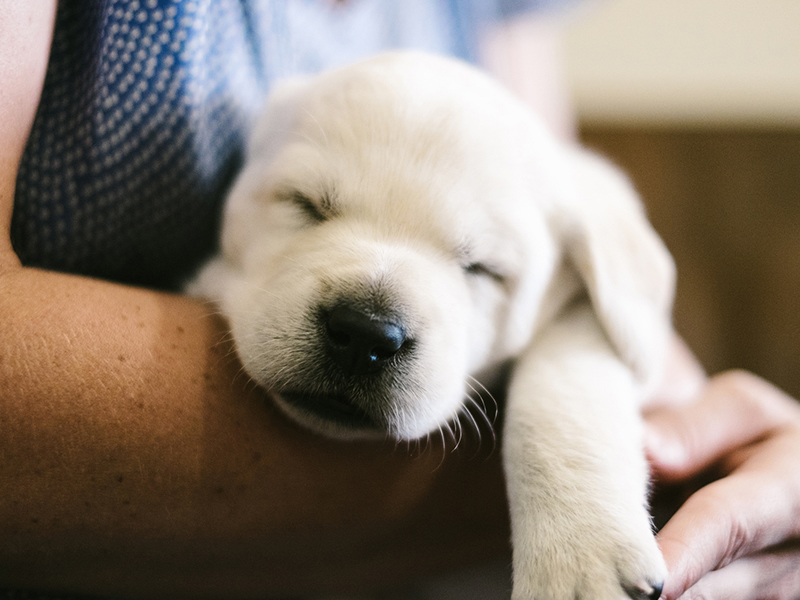
French Bulldog
Breed characteristics
- Size
- Small
- Exercise
- Up to 1 hour per day
- Size of home
- Flat/ Apartment
- Grooming
- Once a week
- Coat length
- Short
- Sheds
- Yes
- Lifespan
- Over 10 years
- Vulnerable native breed
- No
- Town or country
- Either
- Size of garden
- Small/ medium garden
About this breed
The French Bulldog can claim part of its ancestry in Great Britain, going back to the 1850s when a dwarf Bulldog breed known as the Toy Bulldog was popular in some parts of the country.
Nottingham lace makers, threatened by redundancy in the Industrial Revolution, emigrated to Northern France, taking their dogs with them. They became popular in some localised areas. It is thought that some crosses were made to other short-faced breeds and after three decades a new breed known as the French Bulldog had evolved.
Unlike other Bulldog breeds, the French Bulldog has large ‘Bat Ears’ (a term used as a nickname for the breed) giving him a clownish appearance. Soon this was the fashionable breed, popular in artistic society in Paris and portrayed by Degas and Toulouse Lautrec in portraits of Parisian life.
The return of the breed to Britain in the last years of the 19th Century brought some antagonism from the traditionalists, but in 1902 the French Bulldog Club of England was formed. In 1906, The Kennel Club gave official recognition to the breed.
In recent years the breed has seen a meteoric rise in popularity. From 2009 to 2015 the registrations for the breed increased 10 fold and in 2015 the French Bulldog was ranked third most popular breed in the UK.
Images for this breed
The Utility breed group
This group consists of miscellaneous breeds of dog mainly of a non-sporting origin, including the Bulldog, Dalmatian, Akita and Poodle. The name ‘Utility’ essentially means fitness for a purpose and this group consists of an extremely mixed and varied bunch, most breeds having been selectively bred to perform a specific function not included in the sporting and working categories. Some of the breeds listed in the group are the oldest documented breeds of dog in the world.
Colour Watch
Category 4: Breeds with >30% registered NBS colours or more than 1000 NBS registrations per annum
Breed Standard colours
Breed standard colour means that the colour is accepted within the breed standard and is a traditional and well-known colour in this breed.
Breed standard colours in this breed include:
- Brindle
- Light Brindle
- Dark Brindle
- Brindle & White
- Fawn
- Fawn & White
- Fawn Pied
- Fawn With Black Mask
- Pied
Non-breed-standard colours
- (NBS) Black & Tan
- (NBS) Black & Tan with white markings
- (NBS) Blue
- (NBS) Blue & Tan
- (NBS) Blue with white markings or patches
- (NBS) Blue Fawn
- (NBS) Blue Fawn with white markings or patches
- (NBS) Blue with white, sable, tan markings
- (NBS) Brown
- (NBS) Brown with Tan or white markings
- (NBS) Sable
- (NBS) Sable with Tan or white markings
- (NBS) Red
- (NBS) Cream
Non-breed standard colour means that the colour is not accepted within the breed standard and whilst some dogs within the breed may be this colour, it is advised to only select a dog that fits within the breed standards for all points.
Colour is only one consideration when picking a breed or individual dog. Health and temperament should always be a priority over colour.
Other colour/s
'Other' means you consider your puppy to be a colour not currently known within the breed and one that does not appear on either the breed standard or non-breed-standard list. In this instance you would be directed through our registration process to contact a breed club and/or council to support you on identifying and correctly listing the new colour.
Health
Whether you’re thinking of buying a French Bulldog puppy, or breeding from your dog, it’s essential that you know what health issues may be found in your breed. That's why we've teamed up with Weatherbys Scientific, a leading DNA testing lab, to create our breed specific packages.
To support your health testing journey, we provide our tailored French Bulldog Breed-Specific Package. Giving you the information you need about potential health risks, this package includes test for HC-HSF4 (Hereditary cataracts), essential for this breed just for £60, saving you time and providing vital health information.
More about health
We advise that breeders use DNA tests, screening schemes and inbreeding coefficient calculators to help breed the healthiest dogs possible.
Priority health schemes and tests
The Kennel Club's Assured Breeders must use the following (or equivalent) schemes, tests and advice. All other breeders are strongly advised to also use these.
Important health schemes and tests
We strongly recommend that all breeders, both assured breeders (ABs) and non ABs, use the following (or equivalent) schemes, tests and advice.
- Eye screening scheme (BVA/KC/ISDS)
- DNA test - HC-HSF4 - part of The Kennel Club’s DNA Testing Services* (see below). Find lists of tested dogs
- Check inbreeding calculators
- Breed club – Participation in the French Bulldog Health Scheme
Other health schemes and tests available
- DNA test - HUU
- Risk test (DNA based) - DM - Find lists of tested dogs
*The Kennel Club’s DNA Testing Services - simple to use and easy to organise all-in-one DNA tests
The DNA tests listed above marked with an asterisk (*) are included in our DNA Testing Services. This includes:
- HC-HSF4 (Hereditary cataract)
Kennel Club Assured breeders and Kennel Club Accredited Instructors receive a 10% discount.
Find out more about our DNA Testing Services.
Find out about a particular dog's results
Please visit our Health Test Results Finder to discover the DNA or screening scheme test results for any dog on The Kennel Club's Breed Register.
You can also view the inbreeding coefficient calculation for a puppy's parents, or for a dog you're thinking of breeding from.
Health issues in flat-faced dogs
Dogs with a flat, wide-shaped head, are said to be brachycephalic (brachy, meaning short and cephalic, meaning head). This particular skull shape will often give these dogs a characteristic flattened face and a short muzzle. Although the shape of these dogs’ heads can make them look very cute, dogs with a very flat face and short muzzle have a higher risk of developing certain health issues associated with their features. Some of these issues are outlined below, but for more information on the health and welfare of flat-faced dogs, visit our brachycephalic hub.
Breathing difficulties
The soft tissue in the nose and throat of some brachycephalic dogs may be excessive for the airways, making it difficult for them to breathe normally (causing heavy panting or noisy breathing). Some dogs may also have narrow nostrils making it even more difficult to breathe.
More information can be found:
- in our film about breathing problems in flat-faced dogs
- from the University of Cambridge website
- within our article on breathing problems in flat-faced dogs
Skin problems
Some brachycephalic dogs may have an excess of skin, which creates folds, especially around the front of the face. These folds can make a warm, moist environment which is perfect for bacteria and yeast to grow, possibly leading to infection and severe itching.
More information can be found in our article on skin problems in flat-faced dogs.
Teeth problems
Dogs with a shortened skull will often have a shortened jaw, but the number and size of teeth will stay the same. This can mean that the teeth become overcrowded and can cause dental and gum problems.
More information can be found on our advice page on how to take care of your dog's teeth.
Eye conditions
Some brachycephalic dogs may have shallow eye sockets, causing their eyes to become more prominent and at a higher risk of trauma, ulcers and increasing the chance of them becoming dry and painful (due to not being able to blink properly).
More information can be found in our article on eye problems in flat-faced dogs.
Want to buy a puppy responsibly?
Not all flat-faced dogs will have the health issues described, but it is important that if you are thinking of buying a puppy, that you take extra precautions.
Have any questions about health in your breed?
If you have any concerns about a particular health condition in your breed then you may wish to speak to your vet or you could contact your breed health co-ordinator.
Breed health co-ordinators are individuals working on behalf of breed clubs and councils who are advocates for the health and welfare of their chosen breed. They acts as a spokesperson on matters of health and will collaborate with The Kennel Club on any health concerns the breed may have.
To contact your breed health co-ordinator please email
For more information on the health of this breed, please visit the French Bulldog Club of England health pages.
The Breed Health and Conservation Plans
Our breed health and conservations plans (BHCPs) use evidence and data to help us understand the health issues found in each pedigree dog breed. These plans help breeders and owners identify health and welfare problems and use information, health tests and health schemes to avoid passing on those problems to future puppies. They also support and provide breeders with tools and specialist expertise to help manage genetic diversity, understand the impacts of close breeding, and find the best ways to preserve the population of their breed.
Working together for the breed
We’ve worked with breed clubs and breed representatives to gather all available evidence to help us determine the priority concerns for the breed and decide how we can work together to manage and reduce these problems.
Breed priorities
The current key priorities for the breed are:
- Brachycephalic obstructive airway syndrome (BOAS)
- Spinal disorders
- Allergies
How we plan to make improvements
We’ve agreed the following list of actions with the breed clubs to improve the health of the breed. Both parties are committed to working on these areas and will review these on a regular basis to ensure the actions remain focussed and relevant to the breed’s health.
Breed Club actions include:
- The breed to continue to support and attend the Brachycephalic Working Group with our additional support - ONGOING
- The welfare groups to send their collected health data to us for analysis - ONGOING
- The breed clubs to encourage participation in the Respiratory Function Grading Scheme, with a target to improve upon the uptake to date, and every breed club to hold a testing session - ONGOING
- The breed clubs to take the amended breed standards to their clubs’ annual general meetings and feedback to us – COMPLETE (this action was completed in 2022, with the revised breed standard published in 2022)
- The breed clubs to send details for all health testing events to us for inclusion in the health calendar - ONGOING
- The breed clubs to update and/or include general skin care advice on their websites
- The breed clubs and ourselves to monitor the incidence of heart disease in the breed – IN PROGRESS
Our actions include:
- To keep the breed updated with regard to the development of the neurology scheme - ONGOING
- To monitor outcomes and/or research on allergies, specifically with regard to skin problems, which include the French Bulldog - ONGOING
- To fund and progress the development of a body condition score chart for the breed, in collaboration with the University of Cambridge – IN PROGRESS
- To review the breed’s status as a Category 2 breed under Breed Watch – ON HOLD (this action is currently on hold due to Breed Watch being under review)
- To take the proposal to remove degenerative myelopathy (DM) DNA testing from the Assured Breeders Scheme, and assess the test’s validity before reinstating – COMPLETE (this action was completed in 2021)
- To take the proposal to the BVA/KC/ISDS Eye Panel Working Party for the removal of HC-HSF4 from the Known Inherited Ocular Disease (KIOD) schedule, and investigate the feasibility of developing a grading scheme for brachycephalic breeds – IN PROGRESS
The full evidence base is available at the discretion of the breed clubs, however if you would like to seek access to the full report, please contact our health team.
Health (The Kennel Club)
How do I use this information?
Breeders should be mindful of the top priorities in their breed and ensure they are working to reduce and eliminate the presence of these diseases when choosing to breed their dogs.
Puppy buyers should also be aware of these issues and be sure to ask their breeder how they are contributing towards the above actions, and whether any of these problems have been seen in their breeding lines.
Breed watch
Category 2
Particular points of concern for individual breeds may include features not specifically highlighted in the breed standard including current issues. In some breeds, features may be listed which, if exaggerated, might potentially affect the breed in the future.
Breeding restrictions
There are a number of The Kennel Club's rules and regulations that may prevent a litter from being registered, find out about our general and breed specific breeding restrictions below.
More about breeding
The Kennel Club will not register merle puppies. This is because the merle gene in this breed carries an increased risk of impaired hearing and sight problems.
Looking for a puppy?
Looking for a French Bulldog? Explore our list of puppies and rescue dogs for sale near you.
More information

Need to find out more about a breed?
Use our Find a Club service where you can locate breed clubs that can offer support and advice.

Use our Find a Puppy service
The Kennel Club's Find a Puppy service provides contact details for breeders who have puppies available. Let's help you find your new best friend.

Get the best lifetime pet insurance
At Kennel Club Pet Insurance, we want you to focus on getting the best possible treatment for your dog without worrying about the cost.
